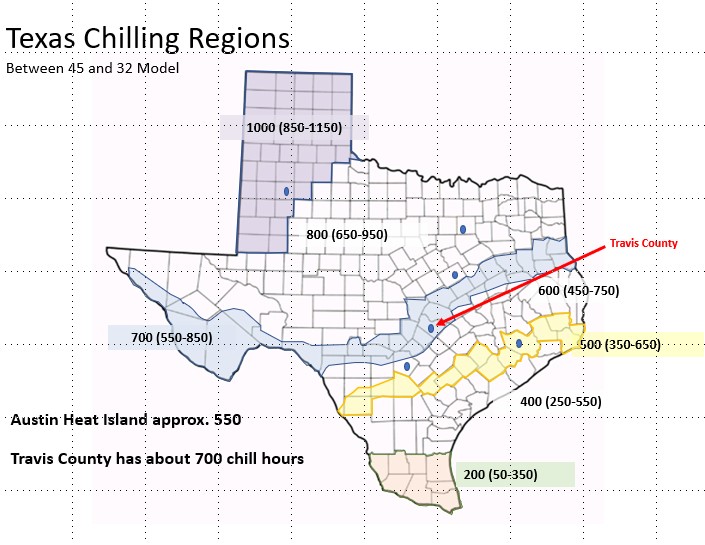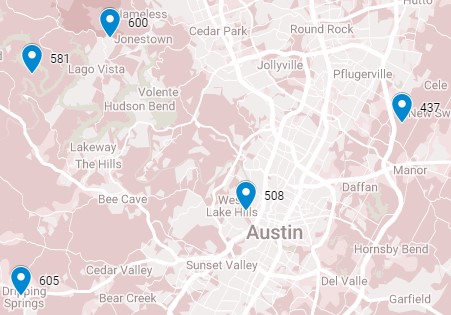Temperate Fruits Need Chill Hours
Many of the fruits available in the grocery store, such as apples, pears, peaches, plums, grapes, and berries, are adapted to climates in the middle latitudes of our planet. Middle latitudes are referred to as temperate zones, thus the term “temperate fruits.” Temperate fruits require dormant cold periods to complete their life cycle. The ability to become dormant during the cold also provides varying degrees of winter hardiness.
The cold weather requirement of dormant buds to grow, flower, and develop properly is commonly referred to as the chilling requirement. The required cold periods vary widely by species. Chill is measured in hours, units, or portions. There are several models for calculating chill hours. The most widely adapted method, (Between 45 and 32 Model) calculates the number of hours where temperatures are between 32◦ and 45◦F. Your success with growing fruit is greatly dependent on understanding the chill hour requirements.
Dormancy Physiology
So what is actually happening? Do plants have a calendar?
In the late fall and early winter, fruit trees go into dormancy and hormones within the plant suppress the bud until temperatures warm up and the days lengthen in the spring. The hormone that causes the plant to go into dormancy breaks down in the temperature range of chill hours. In an ideal winter, the hormone has enough chill hours to completely break down by the time spring comes around and the tree needs to begin blooming.
The weather in Central Texas can play havoc with this process. It’s not uncommon for unseasonable warm and cold temperatures in January and February. This can trick some trees into blooming early (and then freezing) or delay blossoms into late spring.
Find Your Chill Hours
Texas A&M AgriLife Extension has created the following Chill Hour map for Texas. 
Travis County is in the 700 hour region with a range of 550 to 850 hours. That’s a big variation, and the reason has to do with our local geography. A fruit tree needing more than 850 hours is not going to bloom correctly if your neighborhood has less than 550 hours. Or a tree rated for 550 hours may be damaged by frost in an area that typically has 900 chill hours.
You can find the chill hours reported for weather stations near your location by using the TexasET Network page. Go to about the middle of the page in the South Central grouping and find the location nearest you. Click on the location and then choose “Chill Units” at the top of the table. (NOTE: Choose any station other than those with an asterisk. The TexMesoNet data hasn’t been integrated fully into the chill unit models.)

Between 45 and 32 Model used, date range 10/1/2023 through 3/31/2024
As you can see from the map, there is quite a bit of variance between the stations. The trees you select if you live near Pflugerville or Dripping Springs can make a difference in the amount of fruit you hope to harvest.
Fruit Without Cold Requirements
There are some subtropical fruits that don’t require cold but have slight frost tolerance, such as citrus, figs, olives, persimmons, pomegranates, and loquats.
Strategies for Tree Placement
Once you know the chill hour requirements for your tree, you can choose the correct planting site to help facilitate the dormancy period. Here in Austin, cold winter winds generally arrive from the northwest. Warmer winds typically come from the Gulf in a southeast direction. This means that you can use structures or wind breaks to manipulate micro-climates to your favor. If you have a tree with a higher chill requirement, plant it on the northwest side of your property where it can get the full blast of the cold. Subtropical trees like loquats will do better on the southeast side of your property. Using your house, other trees, or hedges as a windbreaks will provide additional shelter from icy blasts.
Additional Resources for Chilling Requirements
TexasETNetwork Chill Units Pick the location nearest you and then select chill units.
Additional Fruit & Nut Resources
Fruit Varieties for Travis County
Aggie Horticulture Fruit and Nut Resources
Fruit and Nuts for Austin Overview
Homeowners’ Guide to Pests of Peaches, Plums and Pecans
